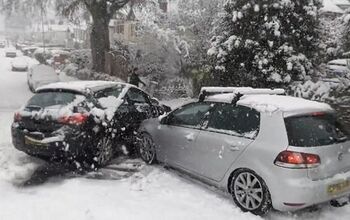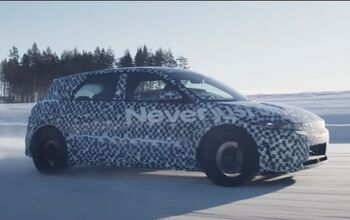Winter Driving Manifesto
Ah, the first snow of the year. The frozen blanket transforms even the ugliest landscapes into crystalline sanctuaries. Crisp air fills the lungs and the inevitable homey smell of a wood fire tells of a distant warming hearth. Earth’s annual metamorphosis triggers a few moments when we get to live a dream stolen from the cover of an old December issue Saturday Evening Post. But for too many, this winter wonderland fantasy is abruptly cut short by the sickening sound of exploding metal, glass and plastic, because the first snow of winter also invites a rash of traffic accidents.
I spent ten winters in northern Utah. Every year, highways ground to a halt from hundreds of traffic accidents on the first day that snow accumulated on road surfaces. I thought, these are Utahans, they should know how to drive on snow. What’s the deal?
Driving on snow and ice requires a recalibration of our timing. By the end of the summer, we don’t think about how long it’s going to take us to brake for an upcoming stop sign on naked pavement; we feel it. Our ingrained habits betray us when water, snow and ice rudely come between us and the road surface. We need practice.
Coming from Texas, I feel disadvantaged driving through white-capped Wasatch Mountains. As George Strait crooned, there’s no Snow in San Antonio. So at the first accumulation of snow, I hop into my old Camry and head for empty parking lots and sparsely traveled back roads for a little automotive me-time.
With no other cars around, I experiment to find out how fast I can corner and stop. I also test to see how steep a road I can safely climb or descend. I re-learn how to finesse both brake and throttle. Back in traffic I’m rightly adjusted to slow-up and allow for proper intervals.
Each year, I repeat this practice ritual at first snow fall. it’s kept me accident-free through rough Rocky Mountain winters.
But despite the drill, getting caught in a blizzard in my trusty old front-wheel drive Toyota still took its toll. I vividly remember white knuckling my way through several snow storms on the road home from grandmother’s house (literally) with my wife and small kids, as I struggled to keep the car on the road and avoid hitting or being hit by other drivers. While the greatest winter driving safety device is the lump of fat and knot of neurons floating between a driver’s ears, equipment also plays a role.
First and foremost are the right tires. On snow and ice, a good pair of snow tires can make even the worst rear wheel-drive (RWD) car a significantly more competent machine. Conversely, the most advanced all wheel-drive systems are rendered impotent with summer meats or worn treads.
Traction control (TC) has emerged as a great equalizer for RWD cars. TC uses either the Anti-lock Brake System or electronically controlled clutches to transfer engine torque to the wheel with the best traction. Last winter I drove a convertible Mustang (top up) through a Chicago snow storm. Despite the superabundance of torque, the pony car’s rear-end stayed safely behind me at all times, without so much as a slip or stall. With the TC off, I turned enough doughnuts to feed the entire Chicago PD.
It would seem that AWD or four-wheel drive cars and trucks are less safe than FWD. Very often we see that the first drivers to slide off the road when the weather turns bad are at the wheel of these “super capable” cars and trucks. But overconfidence is a form of driver error, not equipment failure.
This is an important distinction. When Jack Frost catches a cold, technically the best-equipped cars and truck for safely driving are AWD and 4WDs with appropriate tires.
In low-friction environments, being able to put power to all four wheels can provide up to four times greater traction while acceleration or pulling through a corner over a RWD or FWD car without traction control. To an extent, 4WDs also help in braking due to increased power train drag that allows drivers to moderate their speed without hitting the brakes.
On the down side, these systems add weight and neither improves braking or cornering (except while accelerating). And that’s where lame brain drivers get in trouble. The ability to accelerate on the slippery stuff seems to drain IQ points from drivers.
And so we come full circle. While equipment can help aid drivers, the greatest factor is the man or woman gripping the steering wheel. I love the change in seasons and look forward to winter sports, or just messing around in the snow. But when it gets icy and dicey, nothing beats proper snow tires steered by a calm, practiced, alert and sensible driver.
More by William C Montgomery
Latest Car Reviews
Read moreLatest Product Reviews
Read moreRecent Comments
- Redapple2 Love the wheels
- Redapple2 Good luck to them. They used to make great cars. 510. 240Z, Sentra SE-R. Maxima. Frontier.
- Joe65688619 Under Ghosn they went through the same short-term bottom-line thinking that GM did in the 80s/90s, and they have not recovered say, to their heyday in the 50s and 60s in terms of market share and innovation. Poor design decisions (a CVT in their front-wheel drive "4-Door Sports Car", model overlap in a poorly performing segment (they never needed the Altima AND the Maxima...what they needed was one vehicle with different drivetrain, including hybrid, to compete with the Accord/Camry, and decontenting their vehicles: My 2012 QX56 (I know, not a Nissan, but the same holds for the Armada) had power rear windows in the cargo area that could vent, a glass hatch on the back door that could be opened separate from the whole liftgate (in such a tall vehicle, kinda essential if you have it in a garage and want to load the trunk without having to open the garage door to make room for the lift gate), a nice driver's side folding armrest, and a few other quality-of-life details absent from my 2018 QX80. In a competitive market this attention to detai is can be the differentiator that sell cars. Now they are caught in the middle of the market, competing more with Hyundai and Kia and selling discounted vehicles near the same price points, but losing money on them. They invested also invested a lot in niche platforms. The Leaf was one of the first full EVs, but never really evolved. They misjudged the market - luxury EVs are selling, small budget models not so much. Variable compression engines offering little in terms of real-world power or tech, let a lot of complexity that is leading to higher failure rates. Aside from the Z and GT-R (low volume models), not much forced induction (whether your a fan or not, look at what Honda did with the CR-V and Acura RDX - same chassis, slap a turbo on it, make it nicer inside, and now you can sell it as a semi-premium brand with higher markup). That said, I do believe they retain the technical and engineering capability to do far better. About time management realized they need to make smarter investments and understand their markets better.
- Kwik_Shift_Pro4X Off-road fluff on vehicles that should not be off road needs to die.
- Kwik_Shift_Pro4X Saw this posted on social media; “Just bought a 2023 Tundra with the 14" screen. Let my son borrow it for the afternoon, he connected his phone to listen to his iTunes.The next day my insurance company raised my rates and added my son to my policy. The email said that a private company showed that my son drove the vehicle. He already had his own vehicle that he was insuring.My insurance company demanded he give all his insurance info and some private info for proof. He declined for privacy reasons and my insurance cancelled my policy.These new vehicles with their tech are on condition that we give up our privacy to enter their world. It's not worth it people.”


































Comments
Join the conversation
My 2008 Wrangler with brand-spanking new Bridgestone snow-tires and 4WD-Low will STILL spin out of control on icy patches in Montreal. It's a fine line between getting to work and landing in a ditch, or worse. How the millions of FWD Echos and Cobalts do it everyday with worn-out snow tires is a mystery.
Um...you'll want to stay out of 4WD-Low. The idea of driving well on low-friction surfaces is to keep the torque way down. The "Lo" increases the torque at a given speed. For example, in "Hi" you may be running 1,000 revs at 5 mph in first gear (below the peak torque of the typical, long-stroke, OHV domestic engine). In "Lo" however, you may be running 2,500 rpm at 5mph and have a lot more torque, ergo, propensity to spin. Leave "Lo" for low-speed, high-torque applications...like stump pulling. Little FWD cars have it easy. Their engines don't make a whole lot of torque, nor do they have transfer cases to increase torque at low operating speeds. Additionally their weight is generally concentrated over their driven wheels and their center of gravity is lower. That - and putting it "Lo" is why you see Jeeps, Blazers, Durangos...in the ditch as you motor by in your fwd econobox. Me, I'll take my Subaru with Pirelli Sotto Zero ZR-rated snows.